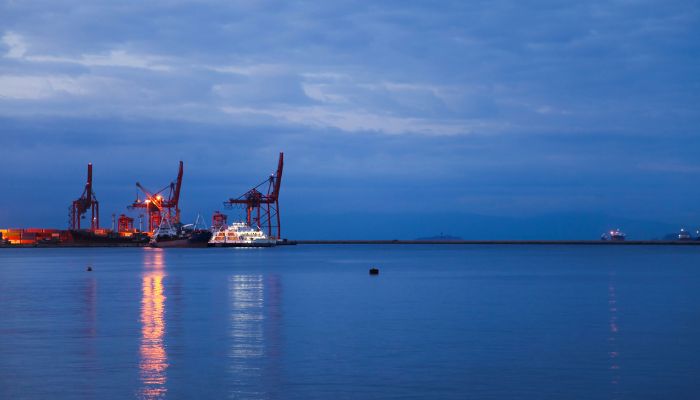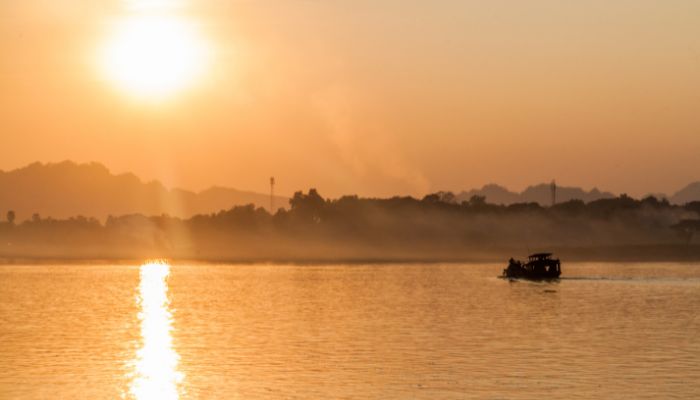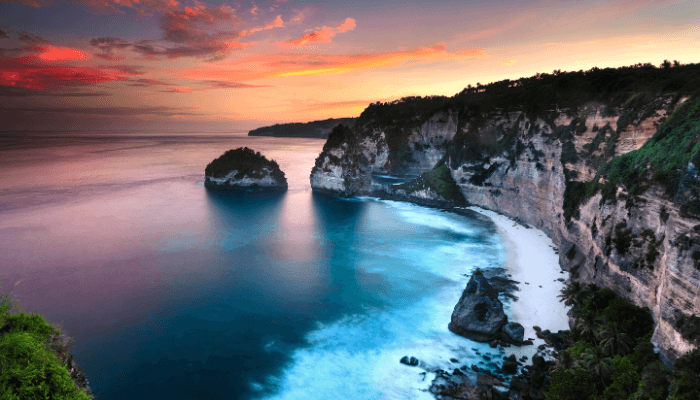7 Major Ports In Burma
The Southeast Asian nation of Myanmar, or Burma, is one of the world’s fastest-growing economies, with a nominal GDP of 76.09 billion US dollars in 2019. The country has suffered the brunt of civil wars and political unrest in the past decades leading to high levels of poverty, corruption and unemployment. However, with the implementation of historic reforms, Burma has attracted considerable foreign investment from countries like China, the Philippines, South Korea, Thailand and India.
Precious gems and stones like pearls, jade and sapphire are abundant. Ninety per cent of the world’s purest rubies are exported from Myanmar. Other important industries include agro-based products, timber, construction material, metals, oil and natural gas.
Myanmar has 1200 miles of continuous coastline along the Sea of Andaman and the Bay of Bengal. The country has highlands and fertile lowlands divided by mountain ranges and river systems. The longest river is the Irrawaddy which empties into the Gulf of Martaban. Most of the country’s major ports and terminals are located on the sea coast or in the delta region. The following are the seven important ports of Burma.
1. Port of Yangon
Yangon is the principal port of Burma, handling around 90% of the country’s international maritime trade. Earlier known as Rangoon, the port lies at the confluence of rivers Yangon, Pazundaung Creek and Pegu. It comprises over 30 wharves divided among the port’s many terminal facilities. Different cargo types are handled at the port, ranging from rice, coal, oil and metal to general cargo, containers and RORO. The total cargo throughput of the Yangon port stood at 23,958,085 Tonnes in 2019.

Myanmar Integrated Port Limited
A multifunctional terminal or sub-port covers 37 acres for handling bulk liquid cargo such as refined oil, general cargo, RORO, project cargo, cruise ships, and bulk carriers. It is equipped with the latest infrastructure and stevedoring equipment.
Old Yangon Port Area
The Old Yangon port area comprises four terminals and 15 wharves for accommodating ships weighing up to 30,000 DWT.
Myanmar Industrial Port
Opened in 2003, it is a container handling facility comprising two container terminals. It also incorporates a six-storey-customs bonded warehouse covering 22,200 sq m, a 100,380 m2 container yard and a 6000m2 container freight station. It can handle around 1200 TEU every day.
Asia World Port Terminal
This terminal is situated on the Yangon River, just 30 kilometres from Elephant point on the Martaban Gulf. Developed by Asia Port Management Co.Ltd, it consists of 4 piers with alongside depths of 9.5 m and a total quay length of 450 m. These berths usually handle general cargo vessels and liquid cargo. Roro facilities are not available at this terminal; however, it has ten fuel storage tanks.
Wilmar Myanmar Port Terminal
This terminal was opened in 2018 and is the third general commodity jetty built under the supervision of Myanmar Port terminals. Covering 235 m with an average water depth of 13 m, it can easily handle available cargo vessels, bulk cargo and edible oil.
Green Asia Port Terminal
Covering 25 acres, this terminal consists of a 175 m-long jetty for loading and unloading fuel tanks with a capacity of 15 million gallons.
Bo Aung Kyaw Street Wharf or TMT Port
In the Botahtaung area of Yangon, the TMT port is operated by Myanmar Economics Holdings. It has weekly container and bulk vessel connectivity to the neighbouring nations of Singapore, Vietnam, Malaysia, Bangladesh, India and China. It consists of three dedicated berths catering to only container ships and general cargo vessels.
Ahlone International Port Terminal
Lying on the eastern bank of the Yangon River, this modernized terminal spans 19,000 m2 and consists of designated berths for handling containers and general cargo.
Sule Pagoda Wharves
This is the biggest terminal in the Inner Harbour of Yangon and incorporates seven wharves with a total length of 1040 m for handling general cargo. It also has good storage areas, including 36,800 m2 of open yards and 67,000 m2 of sheds. More than 35% of the general cargo of the Yangon port is handled at this facility.
Oil terminals
There are two major oil terminals at the Yangon port. The Myat Myittar Mon Petroleum Terminal consists of four storage tanks for storing petroleum. The terminal wharf covers 220 m and can easily accommodate 15,000 DWT oil tankers. The Great Petroleum Oil terminal is Myanmar’s first private petroleum terminal, established by Apex Gas and Oil Company. It handles gasoline and diesel and also provides logistics-related services.
Dry Ports
A recent addition to the port infrastructure is the two dry ports, the Ywar Thar Gyi in Yangon and the Myit Nge in the Mandalay area. They were built in 2018 by the Resource Group Logistics to increase the logistics capacity of the country. They are intended to reduce port congestion and freight costs and are directly connected to the railway network.
2. Thilawa Port or Myanmar International Terminal
The Port of Thilawa is the biggest terminal in Myanmar, mainly used by RoRo ships. A subsidiary port of Yangon, it is strategically located near the Thilawa Special Economic Zone. It comprises two sub-terminals and six wharves, capable of accommodating ships weighing 20,000 DWT, with an LOA of 200 m and a draft of 9 m. It can also handle container ships, feeder vessels and 35,000 DWT conventional cargo vessels.

The port covers 75 hectares and has a berthing line of over 1000 m. It is owned by Hutchison Port Holdings and is managed by Myanmar International Terminal Thilawa, a private company based in Hong Kong. Expansion works ended in 2020, and it can accommodate 5 Panamax-size ships at once. It contains the latest port equipment, including two gantry cranes, five mobile cranes, 15 port tractors, 28 forklifts, ten front loaders and 56 trailers.
3. Port of Bassein/ Pathein
The Bassein port is located near the mouth of the Bassein River. It is easily accessible and comprises numerous public berths and private jetties; however, some jetties are not functional and require dredging to accommodate larger cargo vessels. The port serves the city of Pathein in the Ayeyarwaddy Division, a prosperous agricultural region in the Delta region of Burma. The rural areas are known for their exquisite handmade pottery, Bamboo basket making and colourful parasols.
Pathein is also a significant centre of trade and commerce, especially famous for its small-scale handicraft industries. Many rice mills, sawmills and umbrella manufacturing workshops dot the streets of Pathein. The city’s most prominent sectors include mat making, salt production and bucket manufacture.

It is a major export facility shipping rice and rice products, timber, fruits, sesame, groundnut, jute, maize, tobacco and chillies. It receives shipments of raw materials and scrap metal. The port can accommodate 15,000 DWT ships with an LOA of 140 m and a draught of 6.5 m. Despite its considerable distance from the ocean, it is a crucial delta port of Burma.
Most Pathein wharves handle hovercrafts, small boats, barges and fishing vessels. Wel Kyi Daunt harbour is the largest jetty in the port. It is privately owned and located near the storage shed managed by the Department of Trade Promotion. Some of its warehouses are also operated by the logistics department of the Burmese Army.
This concrete jetty covers 7 metres and can accommodate cargo ships up to 600 GRT. All the jetties are devoid of cargo handling equipment, and manual labour is used for loading and unloading operations, though a few private trucks are operational. Usually, small wooden hull vessels with a capacity of around 100 GRT can be seen in the port harbour.
4. Port of Mawlamyine or Moulmein
Mawlamyine port lies on the Thanlwin River, approximately 25 nautical miles from the Kyaikkami point on Martaban Gulf. It comprises six pontoon jetties, each covering 72 m and two concrete docks spanning 100 m for handling general cargo vessels. The port handles paddy, miscellaneous goods, and general cargo.
It is easily accessible to ships with a 75 m LOA, 2000 GRT and a 5 m draft. Fuel is discharged by the Myanmar Petroleum Products Enterprise using pumps for transferring power from the oil tankers to the storage tanks.

The port does not have advanced cargo handling equipment or container facilities, and cargo is loaded by the workers hired through the Township Labour Office. Storage facilities include two sheltered warehouses owned by the port authority. These 689 m2 warehouses are mainly used for storing rice.
5. Port of Sittwe
Earlier known as Akyab, the Sittwe port lies at the entrance of the River Kaladan. It is a major rice exporting facility but also ships animal hides and salt. Major imports include refined oil, cloth, bags, dried fish and cotton. Approximately 100,000 tonnes of cargo is exported from Sittve, while 25,000 tonnes are unloaded every year.
The port is divided into two main port areas. The biggest is situated in Sittwe downtown and is called the Five Star Gate. The second is the Min Gan port in the southern part of Sittwe. Both are concrete jetties covering 235 m, capable of handling 4000 GRT ships with a maximum draft of 5 m. Small barges carry cargo from the Sittwe port to neighbouring nations.

However, India Investment Corporation is constructing a third facility at the Sittwe harbour as part of the Kaladan Muti-Modal Transit Transport Project for refurbishing Myanmar’s port infrastructure and strengthening maritime relations between India and Myanmar. The new deepwater port would serve as an Indian corridor by directly connecting the eastern Indian seaport of Kolkata with Sittwe port. It is expected to become operational by 2023 since the Zorinpuri-Paletwa road is still under construction.
6. Port of Mergui
The Archipelago of Mergui lies in southern Burma in the region of Tanintharyi. It consists of over 700 small islands, all situated in the Andaman sea near the western coast of the Malay Peninsula.
Mergui is one of the islands lying at the mouth of the Tenasserim River. The Port of Myeik or Mergui has a maritime history of 400 years. It served as an eastern trading outpost of the East India Trading Company and an important commercial centre in those times.

It is a busy river port dealing with different types of cargo, such as rubber products, tin ores, dried fish and rattan. Small fishing vessels and barges can be frequently seen at the port’s three floating pontoons. It has trading relations with Singapore, Malaysia and Thailand.
7. Port of Thandwe
Thandwe port is located in the westernmost region of Myanmar and consists of two wharves. The Tha Pyu Chin dock receives small general cargo ships, while the Jade Taw Jetty, near the Ngapali beach, handles river barges and fishing vessels. The former has no storage facilities; however, the latter comprises eight warehouses, each covering 500 m2.

The Pyu Chaing wharf consists of two concrete piers and a floating buoy with a draft of 6 m. The Myanmar Five Star Shipping Line operated this wharf ten years ago. However, it is currently used by local fishing companies.
You might also like to read-
- 9 Major Ports In Bangladesh
- 13 Important Bay Of Bengal Facts
- 8 Major Ports In Indonesia
- 10 Major Ports In Iceland
- 5 Major Ports In Serbia
Disclaimer: The author’s views expressed in this article do not necessarily reflect the views of Marine Insight. Data and charts, if used, in the article have been sourced from available information and have not been authenticated by any statutory authority. The author and Marine Insight do not claim it to be accurate nor accept any responsibility for the same. The views constitute only the opinions and do not constitute any guidelines or recommendations on any course of action to be followed by the reader.
The article or images cannot be reproduced, copied, shared, or used in any form without the permission of the author and Marine Insight.
Do you have info to share with us ? Suggest a correction
Latest Maritime Knowledge Articles You Would Like:
Subscribe To Our Newsletters
By subscribing, you agree to our Privacy Policy and may receive occasional deal communications; you can unsubscribe anytime.
Web Stories

About Author
Zahra is an alumna of Miranda House, University of Delhi. She is an avid writer, possessing immaculate research and editing skills. Author of several academic papers, she has also worked as a freelance writer, producing many technical, creative and marketing pieces. A true aesthete at heart, she loves books a little more than anything else.




















